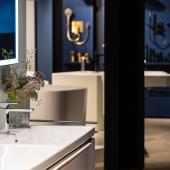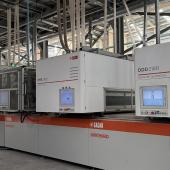Marazzi: Products, services and new competitive strategies

Mauro Vandini (Marazzi Group) comments the evolution of the Italian ceramic tile industry in 2018, facing a general slowdown of the markets and the growing Spanish competition.
Last September Marazzi Group opened the doors to its latest factory, Marlit, created by combining two existing units on the historical industrial site in Sassuolo. Equipped with cutting-edge technologies to guarantee high product quality, operator safety and care for the environment (including heat, water and production waste recovery systems), the factory produces high-end full-body porcelain tiles and will have a production capacity of around 9 million sq.m/year. The production lines extending from the raw materials department through to the packaging zone have a total length of more than a kilometre and a half and occupy an area of more than 50,000 square metres.
The Sassuolo investment follows those made at the facilities in Finale Emilia and Fiorano and includes refurbishment of the Marazzi Laboratories. With a 3,000 sq.m covered area devoted to research into raw materials, bodies, colouring and surface designs, the laboratories develop prototypes and perform stringent tests to ensure the highest levels of technical performance.
“With this latest investment, all our Italian factories are now equipped with state-of-the-art plants, an essential factor for remaining competitive in the high-quality product segment,” said Marazzi Group’s CEO Mauro Vandini. “The factories can and must be transformed if they are to truly fulfil their potential – and in the case of Marlit that means producing our high-end range of sophisticated, natural and beautiful products,” he added.
The investment in Sassuolo has been concluded in the first year of slowdown for the Italian ceramic tile industry after years of recovery. “The economic situation in general is far from easy” – explains Mauro Vandini. “Particularly in the second half of the year, our sector has been facing overcapacity issues caused by a slowdown in some markets, price pressure and competition on two different fronts. The first concerns the high-end ceramic and porcelain tile segment, where Spain is without doubt our most formidable rival. The second consists of growing competition from other floor and wall covering materials that are lighter and easier to install than tiles. Ceramic tiles are certainly more attractive and more natural, so we need to play to our strengths by continuing to improve our products and service, amongst other things”.
Read the complete interview with Mauro Vandini published in Ceramic World Review 129/2018.
Did you find this article useful?
Join the CWW community to receive the most important news from the global ceramic industry every two weeks




















